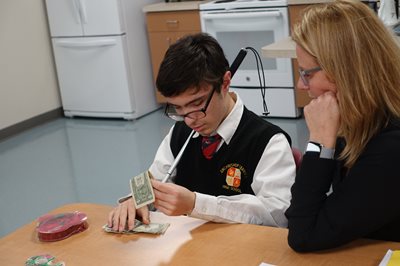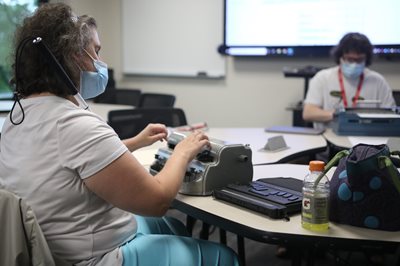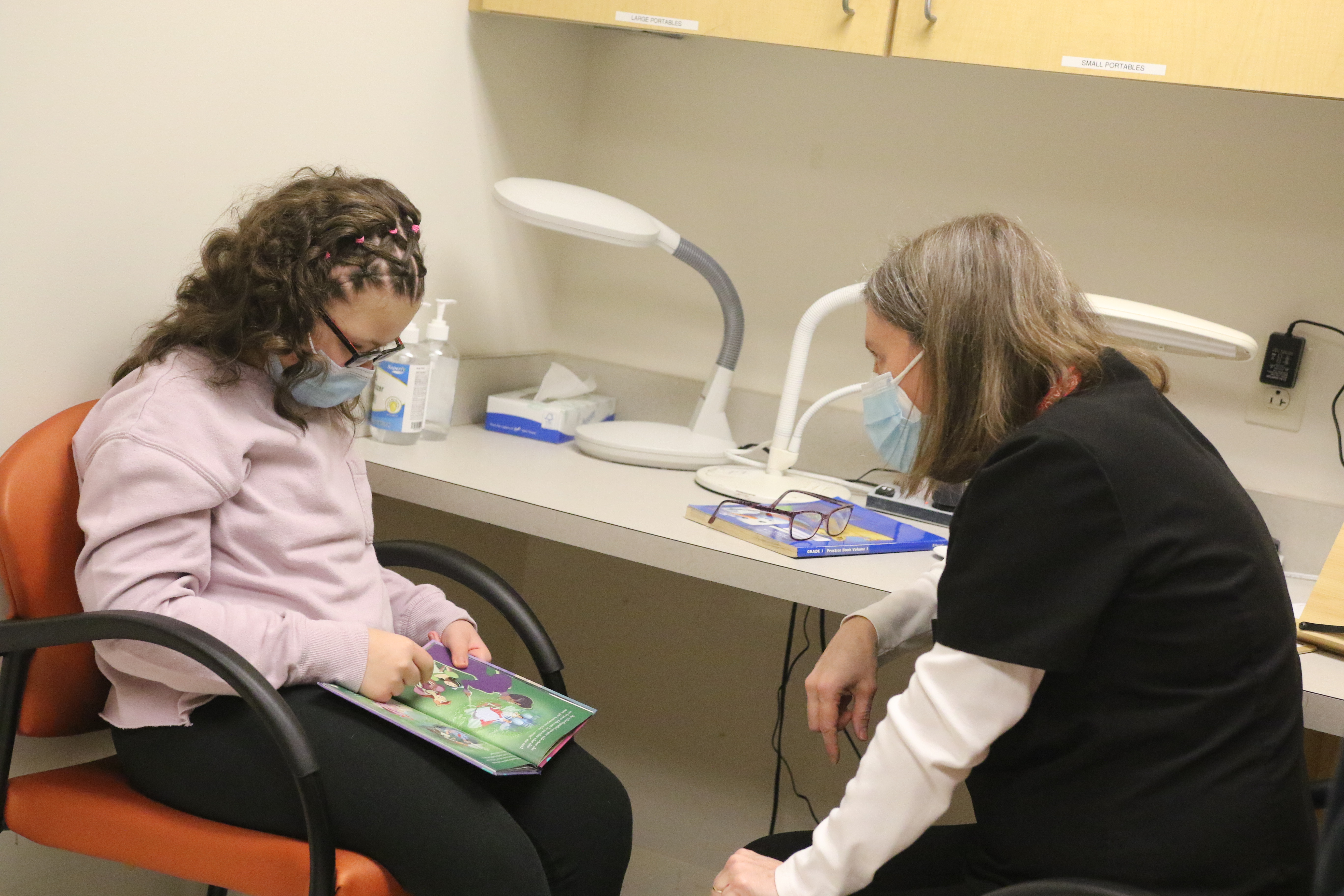In this podcast, BLVS alumni Katelyn (Kate) Maffei, MEd ‘21, TVI, VRT, and Kinshasa Coghill, MS ‘02, CLVT, CVRT, OMS, and current student Carolyn Pijanowski '24VRT, '24OM, share their stories of discovering the blindness and low vision (BLVS) professions, and why people from any background should consider the Salus University BLVS programs.
 Coghill: I am a low vision therapist (LVT) vision rehabilitation therapist (VRT), and an orientation and mobility (O&M) specialist.
Coghill: I am a low vision therapist (LVT) vision rehabilitation therapist (VRT), and an orientation and mobility (O&M) specialist.
Pijanowski: I'm a VRT and O&M student. I'm also the president of Students Promoting Awareness in the Community about Education and Rehabilitation Services for people with visual impairments (SPACERS), which we will talk about later.
Maffei: I'm a teacher of the visually impaired (TVI) and I'm also a VRT. We all have different job roles, but we are all in the blindness and low vision professions. So how did you get into [the BLVS profession]?
Coghill: My major was psychology with a minor in African-American studies. I graduated from Temple University and I was looking for a graduate degree. I knew I wanted to go back to school, and a friend of mine told me about this program. I was super excited because I didn't have to take the GRE [to apply]. At the time, I started at the Pennsylvania College of Optometry (PCO), so my graduate degree is from PCO. In 1999, all I had to do was take the Millers Analogy [instead of the GRE], and I loved it. I was still a little unsure, when people would ask me, “Well, what are you going to go to school for?” I wasn't confident in my answer. Then it just seemed like out of nowhere I saw someone reading braille on the train, and I saw someone with a long white cane. Little did I know I was in the area of the associated services for the blind. Once I saw that, I knew this was the profession [I wanted to be in]. I've been a VRT and a low vision therapist for 20 years.
Pijanowski: My background was in international business and Chinese studies. I was in the business corporate purchasing world, and I liked it. I was good at it, and it was a great job. I went to hang out with my old college roommate, who Kate is hometown friends with, so she tagged along. We had a whole group of us eating ice cream, and Kate was talking about what program she was in, talking about Salus and what she was doing, and as we were getting to know each other, I was like, “Wait, that's a job?” I got your number and kept meeting up with you, doing research and just learning more about the BLVS field and profession. Then I decided to go for it. Now I'm in the VRT and O&M programs here.
Maffei: I love how you can come from any background and if you find a passion in this, you can just go for it!

I took a bit more of a traditional approach with how I got into it, because my undergrad was in elementary and special education, so I was already in the teaching realm. In my senior year at Misericordia University, I was talking with my best friend, McKayla, about what our next step was after we graduated. She told me that she was going to Salus to become a TVI, and I was like, “What is that?” She started explaining it to me, and I started getting interested, doing research, and then as you would have it at my student teaching at a general education school, one of my students in my student teaching class had a visual impairment. I got to see what that was like, I was able to shadow the O&M and see the TVI and see everything kind of come to fruition in a classroom. That was a really special thing for me to see.
I went right into Salus straight from my undergrad to become a TVI and while I was in my classes to become a TVI, I had to take a VRT class. For anyone who doesn't know what VRT is, it's a lot about life skills, independence, things such as medication management, scheduling, cooking, brushing your teeth, and things like that for people who are blind and visually impaired I loved the class, so I just tacked on that VRT to my TVI degree and I'm so happy that I did.
Coghill: When I think about vision rehabilitation therapy, it is your everyday activities, your routine. It's making sure that a person who is living with moderate to severe vision loss can do their daily routine much more efficiently, independently, and safely. I like to look at it from that perspective. When you're a VRT, you work with parents whose children are newly diagnosed with a visual impairment. I enjoy working with teens because a lot of times we can explore things that they didn't think about, opportunities to take a walk and really just have an eating tour, something that's specific to them, or cook different things or just make sure that they are preparing themselves for the next steps in their life. That’s what I liked about the VRT profession. It allows you to help individuals with their everyday routine because everyone's routine is different.
Maffei: It's all about empowering the individual. I feel like all four of the BLVS professions boil down to empowering people and learning about self advocacy and promoting independence.
You just talked a little bit about VRT, can you also talk about your work as a LVT?
 Coghill: What I enjoy is that many people that we work with still have some remaining functional vision. As a certified LVT, I work along with [my clients] to help them utilize low vision devices, help them understand how and when it's time to use vision and when it's time to use other modalities to get the information, as well as set up their environment so that they can comfortably utilize their devices. For example, if a person is diagnosed with macular degeneration and they receive a handheld magnifier, where I'm coming in is explaining where their spot of vision will be. Maybe we'll do some eccentric viewing so they can feel comfortable with using that spot of vision to utilize the magnifier. Then I'm looking at how we set up the space so that they can be comfortable. In some cases, when you are using a magnifier, you want to make sure that you're not bending over, making sure that the light is positioned a certain kind of way and implementing breath breaks. I like being a low vision therapist because I feel that it goes into VRT, helping you do your everyday routines, and then it also helps with O&M, so while you're traveling, you can use that vision efficiently when necessary, when you are safe.
Coghill: What I enjoy is that many people that we work with still have some remaining functional vision. As a certified LVT, I work along with [my clients] to help them utilize low vision devices, help them understand how and when it's time to use vision and when it's time to use other modalities to get the information, as well as set up their environment so that they can comfortably utilize their devices. For example, if a person is diagnosed with macular degeneration and they receive a handheld magnifier, where I'm coming in is explaining where their spot of vision will be. Maybe we'll do some eccentric viewing so they can feel comfortable with using that spot of vision to utilize the magnifier. Then I'm looking at how we set up the space so that they can be comfortable. In some cases, when you are using a magnifier, you want to make sure that you're not bending over, making sure that the light is positioned a certain kind of way and implementing breath breaks. I like being a low vision therapist because I feel that it goes into VRT, helping you do your everyday routines, and then it also helps with O&M, so while you're traveling, you can use that vision efficiently when necessary, when you are safe.
Maffei: Carolyn, do you want to talk about O&M and what it is?
Pijanowski: Typically, when you see someone walking with a white cane that means they've had O&M lessons before, but it's not just the white cane. It's navigating environments, unfamiliar and familiar. It's indoors and outdoors, using a white cane, learning directional, the compass directions, spatial awareness, how close you are when talking to someone. It’s coming up with routes and methods to get from place A to B, using public transportation, etc. There are a lot of things that O&M does for safe and independent travel. It's not just the white cane, which a lot of people probably think it is when they hear it, but it's a lot more than that.
Maffei: So I'm a TVI, and when you're a TVI, you can kind of take two routes. You can become an itinerant TVI, which is what my best friend McKayla does. She travels from school to school to be a service provider for the different kids who have qualified for vision services. And then I'm a TVI who works at a school for the blind. I'm at the same school all day, every day, with my kids and I love it. My kids are the most amazing children in the world. TVI is such a great option for someone who wants to be in education because you can go two very separate ways.
If you don't want to be in the same classroom all day or don't want to have to deal with constant classroom management, you can become an itinerant service provider. You have some time in your car, you can listen to your music, get from place to place, and you get to work with a lot of different age ranges as well. If you become a TVI at a school for the blind, there are pros there. You get to spend all day, every day with the same kids. You get to really get to know the families. Working in TVI, you can do two very different jobs, but both of them are so fulfilling.